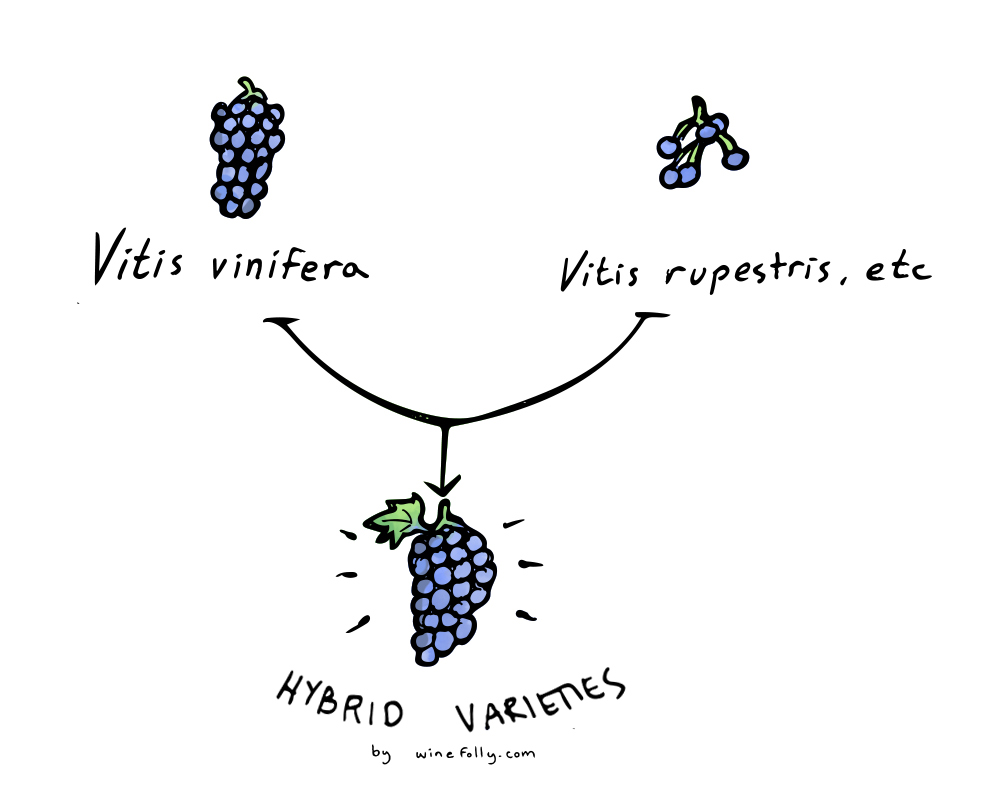Hybrid wine grapes like Chambourcin and Marquette suffer from a long-standing reputation problem.
Most critics disregard them entirely. Critics that taste hybrid wines often use the word “foxy” to describe them. In the wine world, “foxy” is a four-letter word. It’s like saying, “This wine smells like poo!”
Are hybrids wine really that bad? In this tasting, Madeline Puckette explores Chambourcin to find out if hybrid varieties show potential.
What’s the Story with Hybrid Wines?
Nearly all common wines we know (like Chardonnay and Merlot) are cultivars of just one species called Vitis Vinifera (aka the “European grapevine”). Unfortunately, this species doesn’t grow well in humid conditions, nor in places with frigid cold winters.
“Want to go on a wine tour but you live in Minnesota? No problem! Want to grow grapes in Quebec? You got this. ”
So when winemaking came to the Eastern shores of America in the 1800s, botanists started tinkering with grape crosses. Many of the crossings paired native American vines with European wine grapes. The goal was to match the natural disease resistance of the American vines with the delicious taste of the European vines.

It was no small feat. For perspective, one well-known viticulturist named Albert Seibel developed over 16,000 hybrid species during his career!
Of course, breeding new species is not something you’re great at overnight. Most vines take at least three years to produce fruit. Then, winemaking strategies must be tested to figure out what methods work best. It can take decades to develop a new wine grape species!

Hybrids to Know
Here are some popular hybrid grapes worth exploring.
- Baco Noir: A cold climate red grape developed in the 1890s by Francois Baco and grown predominantly in Ontario, Canada. These wines are often described as having tart acidity and rustic berry notes.
- De Chaunac: This was developed around 1860 by Albert Seibel and named after after Adhemar de Chaunac, a pioneer in the Ontario wine industry. Unfortunately, the Canadian VQA system refuses to let growers bottle and label single-varietal wines.
- Vidal Blanc: Developed in the 1930s by Jean Louis Vidal, this cross uses uses Seibel grapes, Trebbiano Toscano, and a popular white wine grape used in ice wine production in Canada.
- Chambourcin: Developed by Joannes Seyve, it has been in the market since 1963. Blackberry fruit flavors with low tannins and juicy acidity describe this type of wine.
- Marquette: This is a recent development first introduced in 2006 by the University of Minnesota. This juicy-fruity red easily survives winter in Vermont and has Pinot Noir in its family tree. Watch this video on Marquette!
Last Word on Hybrid Wines
Even though much of the fine wine industry still shuns hybrid wines, modern breeding programs continue to thrive. The hybrid species allow growers to produce wines in places that would never before seem possible. And, it’s helping build productive communities around wine.
Want to go on a wine tour but you live in Minnesota? No problem! Want to grow grapes in Quebec? You got this.
So, instead of poo-pooing that so-called “foxy” bottle of Marquette or Chambourcin, maybe give it a whirl. It might actually be good!
